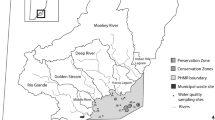Abstract
Construction of the Farakka barrage on the Ganga River in April 1975 to augment water supply to the Calcutta port has brought about a significant increase in freshwater discharge in its distributary, the Hoogly estuary. This has naturally resulted in major changes in the ecology of this estuary, causing modifications in the structure of its fishery resources, fishing pattern, and fish production. This paper presents observations on salinity, plankton, bottom biota, fishery resource, and fish production of different zones of the Hooghly estuary during the period 1982–1992. Comparison with similar studies made before and immediately after commissioning of the Farakka barrage (1975–1977) has revealed that the increased freshwater discharge has resulted in considerable decrease in salinity throughout the estuary. The freshwater zone now extends toward the mouth of the estuary. The true estuarine zone has moved seaward and the marine zone has been restricted to the area near the mouth of the estuary. This has effected major changes in plankton dynamics, sharp decline in the fishery of marine and neritic species in the upper estuary, caused a significant increase in catch ofTenualosa ilisha and an over twofold increase in the average annual fish landings from the estuary as a whole. New zonations have been proposed based on the presently, observed salinity values, which are the most significant factor in determining the fishery of any estuary. An interdisciplinary study of the ecology of the new zones is needed to establish their correct biological characteristics.
Similar content being viewed by others
Literature Cited
American Public Health Association, American Water Works Association, Water Pollution Control Federation. 1980. Standard Methods for the Examination of Water and Wastewater. 15th Edition. American Public Health Association, Washington, D.C.
Bose, B. B. 1956. Observations on the hydrology of the Hooghly estuary.Indian Journal of Fisheries 3:101–118.
De, D. K. andB. N. Saigal. 1989. Spawning of hilsa,Tenualosa ilisha (Hamilton), in the Hooghly estuary,Journal of Inland Fisheries Society of India 21:46–48.
Dutta, N., J. C. Malhotra, and B. B. Bose. 1954. Hydrology and seasonal fluctuations of the plankton in the Hooghly estuary.Symposium on Marine and Freshwater plankton in the Indo Pacific 35–47.
Dutta, P., G. C. Laha, P. M. Mitra, D. K. De, and others. 1973. Fishery resources of the Hooghly-Matlah estuarine system.Bulletin of Central Inland Fisheries Research Institute. Barrackpore 19.
Gopalakrishnan, V. 1971. The biology of the Hooghly-Matah estuarine system (W. Bengal, India) with special reference to its fisheries.Journal of the Marine Biological Association of India 13:182–194.
Jhingran, V. G. 1991. Fish and Fisheries of India. Third Edition. Hindusthan Publishing Coporation India. Delhi, India.
Ketchum, B. H. 1951. The flushing of tidal estuaries.Sewage and Industrial Wastes 23:189–209.
Mitra, P. M., K. K. Ghosh, B. N. Saigal, N. D. Sarkar, A. K. Roy, N. C. Mondal, and A. R. Paul. 1987. Fishing gears of the upper and the middle Hooghly estuary.Bulletin of Central Island Fisheries Research Institute. Barrackpore 49: 22 p.
Nandy, A. C., M. M. Bagchi, andS. K. Majudar. 1983. Ecological changes in the Hooghly estuary due to water release from Farakka barrage.Mahasagar 16:209–220.
Pritchard, D. W. 1955. What is an estuary: Physical viewpoint, p. 3–5.In G. H. Lauff (ed.), Estuaries. American Association for the Advancement of Science, Washington, D.C.
Saha, S. B., B. B. Ghosh, andV. Gopalakrishnan. 1975. Plankton of the Hooghly estuary with special reference to salinity and temperature.Journal of the Marine Biological Association of India 17:107–120.
Saigal, B. N., P. M. Mitra, and H. C. Karamkar. 1987. Migratory winter bagnet fishery in coastal waters of the Hooghly estuary. National Symposium on Research and Development in Marine Fisheries, CMFRI, Cochin.
Saigal, B. N. andM. K. Mukhopadhyay. 1988. Status of estuarine fisheries resources and their exploitation in India, p. 183–188.In A. G. Jhingran and V. V. Sugunan (eds.) Conservation and management of Inland Fisheries Resources. Island Fisheries Society of India. Barrackpore, India.
Shetty, H. P. C., S. B. Saha, andB. B. Ghosh. 1961. Observations on the distribution and fluctuations of plankton in Hooghly-Matlah estuarine system with notes on their relationship to commercial fish landings.Indian Journal of Fisheries 8: 326–363.
Snedecor, G. W. andW. G. Cochran. 1980. Statistical Methods. 7th ed. The Iowa State University Press, Ames, Iowa.
Thompson, R. H. 1959. Algae, p. 115–170.In W. T. Edmondson (ed.) Freshwater Biology. 2nd Ed. John Wiley & Sons, Inc., New York.
Author information
Authors and Affiliations
Rights and permissions
About this article
Cite this article
Sinha, M., Mukhopadhyay, M.K., Mitra, P.M. et al. Impact of Farakka barrage on the hydrology and fishery of Hoogly estuary. Estuaries 19, 710–722 (1996). https://doi.org/10.2307/1352530
Received:
Accepted:
Issue Date:
DOI: https://doi.org/10.2307/1352530




